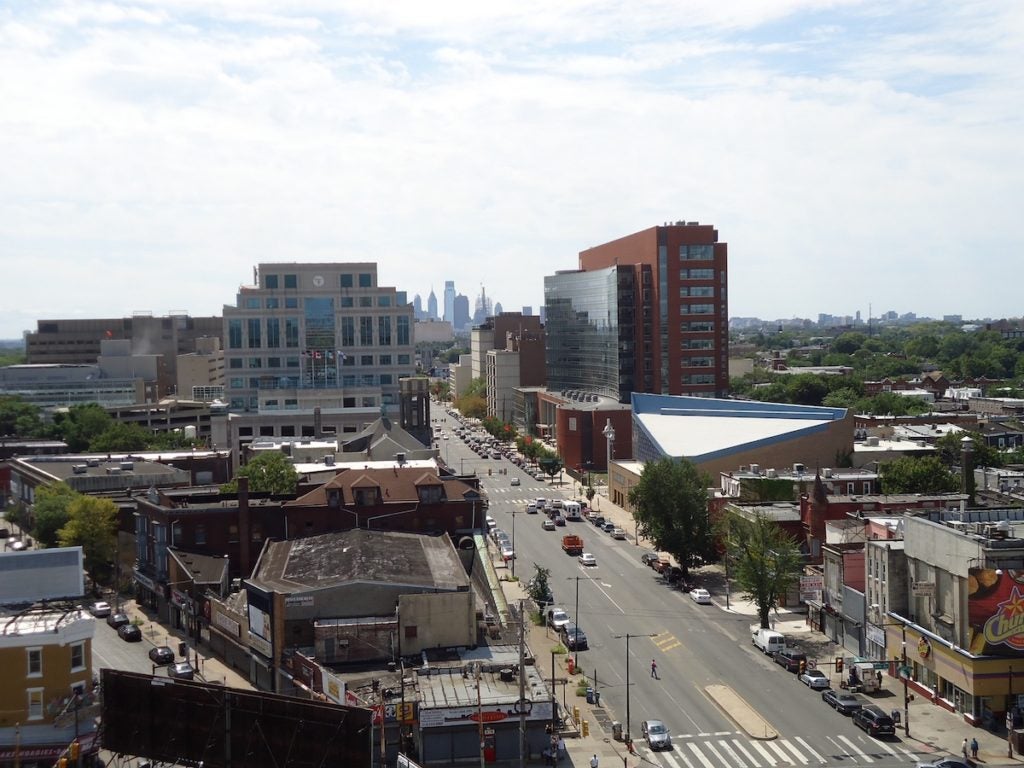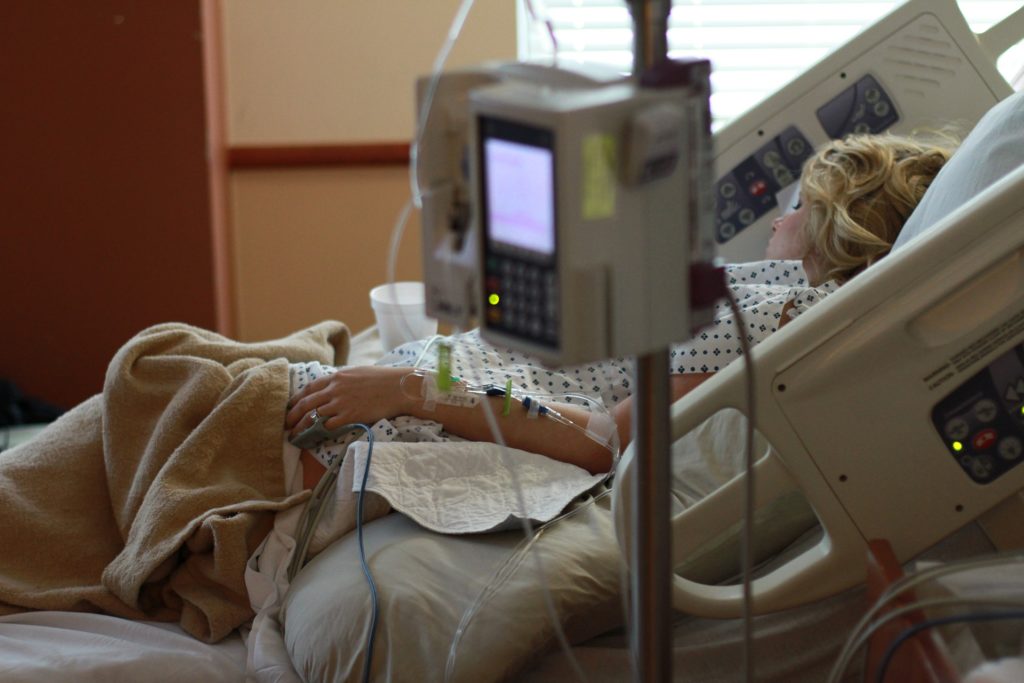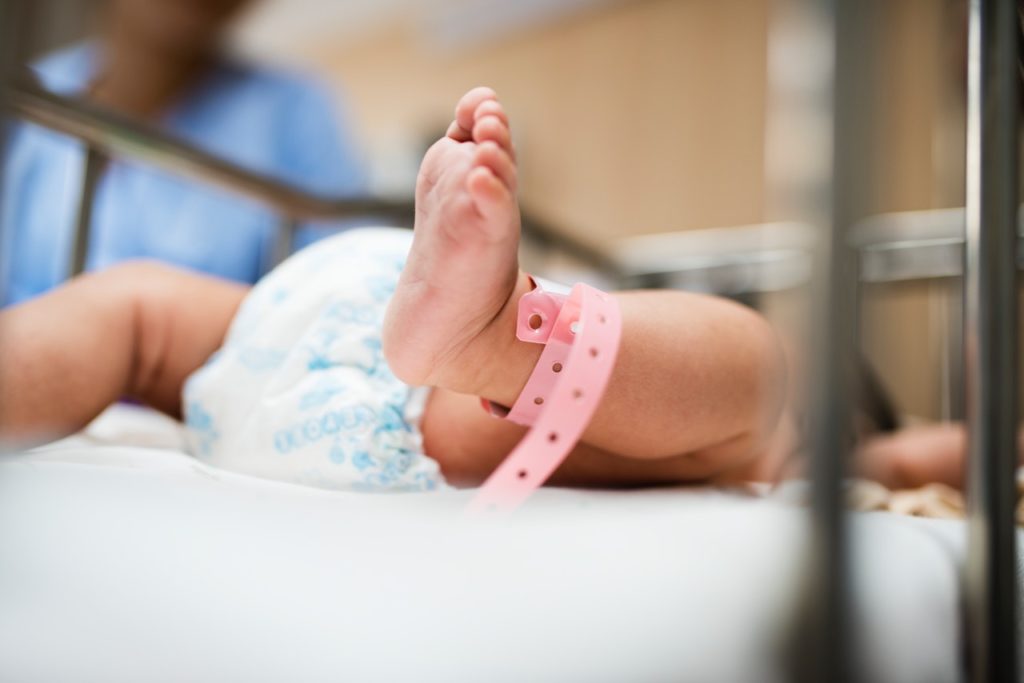Maternity care crisis (averted?)
In the past 20 years, 13 of the city's 19 maternity wards have closed. Philly's maternal mortality rate is high, especially for women of color. Cause and effect? Not so fast.

(Photo by Manuel Alejandro Leon for Pixabay)
This article was supported by the Fuller Project for International Reporting, a nonprofit journalism organization that reports on issues that impact women, in collaboration with Resolve Philadelphia. It originally appeared on Generocity.
—
Dad was speeding down I-95 past the Philadelphia Airport, his heavily pregnant wife moaning in the SUV. The drive was too far; the traffic too congested. Eventually, he pulled over and with the help of arriving State police officers Jean Altomari and Donald Foley, a baby girl was delivered in early August 2009 on the side of the highway near the airport.
True story. But it was assumed to be part of a much larger narrative about maternal health that — surprisingly — hasn’t ended up being true at all.
Starting in the late 1990s and well into the 2000s, maternity wards in hospitals across the Philadelphia region began to close down. Citing financial losses, two-thirds of hospital obstetrics units within city limits shuttered between 1997 and 2012, to go along with a string of suburban shutdowns.
The closures led to alarming stories about women’s ability to access quality prenatal and maternal care. In a 2006 report by the Maternity Care Coalition, experts wrote of “women laboring in hospital hallways,” overwhelmed hospitals, and “rumors that obstetricians were ‘fleeing Pennsylvania’ at record rates.” Doctors hypothesized in op-eds that the closures would push maternal health further down on“crisis course” and access to prenatal care would fall off, as the distance to service grew.
The fears gathered energy from media stories like the one above: women would have such long drives to the few available maternity wards, I-95 would turn into a birthing center.
But a decade later, there’s little data to suggest the mass disappearance of maternity wards has harmed the health of mothers and infants in Philly, despite altering the healthcare landscape in the region. Key metrics like infant mortality were unaffected in the long run. I-95 did not become a birthing center.
In fact, some practitioners are now arguing the opposite of what was originally predicted: The closures, despite the gaps it’s created, might even have improved outcomes.
“Women being born on I-95 while racing to the hospital. Women having difficulties getting prenatal care. Neither of those have happened,” says Karen Pollack, vice president of programs at the Maternity Care Coalition. “When you look at the concerns we had in the middle of all of these hospitals closing units, you have to say now that most of those concerns have not come to fruition.”
Babies born on I-95 notwithstanding, the overall picture of maternal health in the city isn’t rosy. There’s a local deficit of midwives, obstetricians, and gynecologists. Philadelphia still reports a maternal mortality rate of 27.4 deaths per 100,000 live births, which is worse than the rate of all but six states. And African-American moms are twice as likely to die within one year of childbirth in the city, a racial disparity that shows no signs of abating. (Throw in a high concentration of malpractice lawyers in the city and you have a bad recipe for improvement.)
So how likely is it really that the two trends — closures of maternity centers and stubbornly poor maternal health, including high maternal mortality rates — are not linked? And if the inverse is actually true, how?
The answers are complicated.
The alleged culprit: Closures

In the early 2000s, Mercy Health System in West Philadelphia shuttered its maternity ward.
The chief executive of the health system at the time, Gavin Kerr, cited rising insurance premiums for the decision, which forced many physicians to stop delivering babies, in an interview with the New York Times. “We had been subsidizing the program because we had the resources,” he said in the 2002 article. ”But as the malpractice premiums increased, that dramatically shrunk the resources.”
Mercy succumbed to sector-wide pressures, like a lot of hospitals. A nationwide surge in the cost of malpractice insurance — especially acute in high-risk areas like obstetrics — led to a consolidation of maternity care. Local hospital executives, looking to cut costs, turned to reliably money-losing wings for rollbacks. Maternity wards are historically among the first to go.
In Philly, the closures of nine maternity wards between 1997 and 2007 resulted in 40% of all obstetrics beds (the rooms where one-third of all births occurred) disappearing within Philadelphia County.
“It was just a heart-wrenching decision,” says Kerr, now running Building Champions, a strategic leadership consultancy. “There were deep emotions that went with that decision, especially among the sisters and the staff.”
Mercy, a Catholic healthcare provider with locations throughout the metropolitan area, used to deliver north of 5,000 babies per year in the 1980s in West Philly. But it was delivering shy of a quarter of that number by 2000.
“It was as much about quality of care as it was a financial decision. If you’re not doing enough deliveries, the safety of those deliveries declines,” Kerr said. “We had high rates of uninsured patients. The overhead cost [of the maternity ward] wasn’t being spread across enough deliveries. But the final driver for us was that we were doing such low volumes, we did not feel comfortable that our teams were getting enough experience to ensure high-quality maternity care.”
The bottom line for mothers in West Philadelphia is that they had one less choice for where to deliver their babies or seek prenatal care, joining a long list of places across the country grappling with the same shortage. Typically, urban America isn’t the first of these to come to mind. Rural closures have gotten more publicity. Over the last three years, the likes of the Atlantic, Jezebel, and the New York Times have all published stories, along with dozens of research papers, exploring the rural healthcare impact of obstetrical decline.
Philadelphia became one of the only urban areas to be studied in a large-scale research project — undertaken by researchers at CHOP and later published in a paper produced by the Center for Outcomes Research— regarding urban obstetrics closures.
At first, the researchers found alarming evidence. The elimination of obstetrics units corresponded with a 49% increase of neonatal mortality (within the first 28 days of life) over a three-year period beginning in 1997 when the worst stretch of closures began — confirming the worst fears of prognosticators.
But those trends quickly reversed. “After 2000, there was no statistically significant change in any outcome in Philadelphia County compared with the preclosure epoch,” wrote Dr. Scott Lorch, head researcher on the team.
The surviving maternity wards in the area quickly bounced back, adjusting to new volumes. On average, these six units had a 58% increase in births between 1997 and 2012, a later study found. Several beefed up their maternity wards, including Holy Redeemer Hospital, which sits a stone’s throw away from the county line in Northeast Philly. This all happened in spite of the financial picture around obstetrics remaining precarious.
“From a pure medical viewpoint, regionalization has been better for babies,” says Dr. Amy Zucker, director of neonatology at Holy Redeemer. “You have to be in a facility that can recognize internal obstetric emergency and take care of it. You want to deliver at a place that has drills for when there are common maternal problems, and if you’re delivering somewhere where they’re only doing only 600 babies, you can’t keep everyone trained.”
All the remaining NICUs in the city and the majority in the suburbs have neonatal intensive care units (NICUs). That wasn’t the case 15 years ago.
“Today, places that are delivering are mostly teaching hospitals that have lots of equipment and operating rooms, plus they have more highly trained staff for serious situations,” says Pollack. “If you have more providers who are at fewer hospitals, you don’t have people delivering babies at smaller community hospitals without NICUs.”
Except it’s hard to say exactly what’s occurring inside hospital units. Anecdotes abound in online forums about negative experiences at some birthing centers, including Temple University Hospital, which has absorbed deliveries from elsewhere in the city. Until recently, there was no public record of complication rates at area hospitals, which kept that information proprietary.
Last year, a multi-part investigative series by USA Today found that Maternal Mortality Review Committees — existing in the majority of states, and many municipalities — broadly underrate the role that medical professionals have had in the deaths of new moms. “State panels across the country have focused a fraction of their attention on the quality of care hospitals provide or on advocating for improvements,” USA Today wrote.
The reporters found the absolvement of doctors to be nearly universal, despite the less certain realities of these deaths. “The best estimates say that half of these deaths could be prevented and half the injuries reduced or eliminated with better care,” they wrote.
Maternal mortality data isn’t as clear-cut as you’d think, which could be obscuring the true impact of obstetric unit closures.
Maternal mortality rates: Not a true count

The last major report on maternal mortality in Philadelphia was published in 2015 by the city’s health department and in conjunction with an independent, 30-member maternal mortality review committee (MMRC).
Although the committee found that Philadelphia had a 53% higher death rate than the national average over its three-year research window, they didn’t attribute a single death directly to medical negligence by doctors. Only one woman had a “good chance” of being saved through improved care, they wrote.
But the report from the Philadelphia MMRC, like MMRCs across the country, admittedly used an inexact, although the commonly used method for reviewing maternal deaths. “Unfortunately, this number is probably an underestimation of the true count in Philadelphia, as there are likely additional deaths that were not able to be identified by the MMR team and thus never reviewed,” the report’s authors wrote.
Isolating maternal deaths remains difficult. Despite the longevity of the rise in maternal mortality (which has been going up since 1987), there is no standardized tracking of these deaths, such as what occurs systematically for infant mortality. Because of this, it’s quite possible that the deaths of moms — low-income, moms of color in particular — are invisible within the harrowing statistics.
Only a small percentage of fatalities are operative-related, such as deaths by hemorrhages or infections. “Maternal mortality is challenging to track, especially if the death occurs outside of delivery,” says Joanne Craig, vice president for programs at the Foundation for Delaware County and a member of Pennsylvania’s newly formed Maternal Mortality Review Committee. “If a woman dies in childbirth or even within a few weeks, there could be a logical connection. But when a woman dies six months later, there could be no connection made to childbirth.”
Although the definition of maternal mortality is clear, spotting it with rote information is less so. The process of identifying maternal death rates involves the laborious work of combing through death certifications and obituaries and cross-referencing them against birth records and interviews with close relatives. According to experts, it’s assumed that many moms’ deaths are missed in statistics. “If a woman suffering from postpartum depression wanders out in front of a bus, there will be no discussion of the fact that she had a baby two months ago,” says Craig.
The death will be ruled a suicide or an accident instead, not a pregnancy-related death. The same could be true of domestic homicides involving new parents.
In fact, if you look again at the report that gave us Philadelphia’s oft-cited 27.4 maternal mortality rate, it’s a bit misleading. That number is actually only a fraction of deaths — the “pregnancy-related mortality rate” per the MMRC — obviously stemming from obstetrics care. There were an additional 36 deaths ruled out for the purposes of the statistic because the MMRC attributed the mortalities to things like accidents, homicides, or suicide.
Craig believes that Governor Tom Wolf’s newly formed MMRC, which she is part of, will help steer the public health community towards better monitoring and tracking — along the lines of what’s been installed in the death review process to track infant deaths.
“We’re very close. The committee is already formed. Soon, we’ll start reviewing deaths. We’re right at the door of getting a better handle on this,” she says.
Of course, official reports aren’t the only way to assign culpability. Doctors can still be sued for birth injury, which has long been a path for victims in Philadelphia. The extent to which doctors are shielded or not from liability has taken on fresh urgency, however. It’s the subject of a fiery debate currently unfolding in the state capital of Harrisburg, with lawyers, judges, and lawmakers all wrestling with the question.
Some people worry that proposed rule changes in 2019 to malpractice law could set off a whole new set of financial worries for the longevity of maternity wards.
The med-mal effect

What caused the spike in maternity ward closures in the first place back in the early 2000s? Well, it depends who you ask.
The cost of malpractice insurance in Pennsylvania had been rising more sharply than the national average since the late-’90s. Thanks in part to President George W. Bush and national pundits railing against soaring lawsuits and high awards, it became a popular belief that Philly lawyers were chiefly to blame: The city was home to less than 15% of the state’s population, but the locus for more than 50% of all malpractice cases.
“Back then it was open season for suing medical providers, no-holds-barred tort laws, and family-friendly courts and juries. The malpractice costs were skyrocketing at the time,” said one healthcare consultant who was not authorized to speak on the record with me.
In 2003, state provisions signed into law by first-term Democratic Governor Ed Rendell tried to curb the lawsuits. Lawmakers borrowed a page from California, whose legislature instituted strict limits on malpractice lawsuits and high-damage recoveries in 1975, which have been credited for warding off rapid increases in the cost of malpractice insurance. Specifically, the new laws in Pennsylvania outlawed an old med-mal maneuver known as “venue-shopping.” Previously, lawyers were allowed to file malpractice suits in any jurisdiction where the doctor’s medical institution had an affiliation. So when teaching hospital networks began to buy up more community providers, venue-shopping became easier and simultaneously more preposterous throughout the state.
“The best reform that we were able to make was a provision that kept a lot of the lawsuits out of the Philadelphia court system,” says Curt Schroeder, a GOP state lawmaker at the time and now head of the nonprofit Pennsylvania Coalition for Civil Liberties Reform.“ We had a medical malpractice crisis.”
According to a 2003 report by Pew, Pennsylvania’s total malpractice payouts adjusted for population were twice the national average and Philadelphia plaintiffs were twice as likely to win damages in a jury trial than the national average. “If you had a surgery in West Chester” — or even Lackawanna county for that matter — “and you were dealing with a doctor who was part of a larger practice, they would sue you in Philadelphia,” says Schroeder, referring to the well-known track record of plaintiff-friendly conditions in the city.
The venue-shopping rules established an uneasy detente between hospitals and lawyers to drastic effect. In the first full year of the reforms, the number of med-mal lawsuits in the state dropped by more than 1,000, including a 50% reduction (over 500 cases) disappearing in Philly. That number has since leveled off in the city, at roughly 66% of peak levels.
Shortly after the reforms, malpractice insurance prices in Pennsylvania leveled off.
But the correlation between lawsuits and premiums, meanwhile, also turned out to be an exaggeration, according to many experts. The theory that malpractice lawsuits are chiefly to blame for pricier insurance premiums nationally has actually been debunked. Since the insurance nightmare of the early 2000s, many economists have concluded that natural fluctuations in the market, federal policy, and declining earnings at insurance companies drove price hikes, not litigation.
It’s part of the reason why, seemingly out of the blue last December, an advisory committee to the Pennsylvania State Supreme Court suggested the rules were “no longer warranted.” In a letter written to the justices of the court, the committee recommended a rollback of Rendell-era restrictions on venue-shopping in order to “restore fairness” to defendants.
Proponents of the status quo, including Schroder, argue that it’s still possible lawsuits are chiefly to blame for the troubling financial situation facing Pennsylvania’s healthcare sector. The authors of the 2003 Pew report on medical malpractice came to different conclusions than national researchers when studying the problem more locally. “The largest cost component [of insurance hikes] is state-specific — investigating, defending, and paying legal claims,” wrote the authors of that 2003 Pew report.
So the debate rages on.
But the questions of how and where doctors should be sued in Pennsylvania can distract from the more important inquiry at hand: are doctors hurting pregnant mothers and if so, being punished for it appropriately?
The disappearance of obstetrics units in Philadelphia hospitals hasn’t left the maternal health landscape unscathed.
A dwindling pool of practitioners

A follow-up study of the surviving six maternity wards in Philadelphia, published by the same research team at CHOP, found that the closures weren’t without negative externalities.
Inside the remaining wards, low morale and overcrowding became commonplace, with less patient satisfaction. Inner-city hospitals like Temple University and Albert Einstein Medical Center began to take on two to three times the number of publicly insured and uninsured patients, exacerbating the financial burden of generally unprofitable obstetrics work.
It’s also taking a psychic toll on patients, research suggests. A 2010 survey-based study of mothers enrolled in Women, Infant, and Children (WIC) benefits, all of whom lived in Philadelphia, found that one in three cited recent closures of delivering hospitals as having a negative effect on their pregnancy. The perception that mothers are getting worse care is a consequence in itself.
For more than a decade, maternal health experts have warned of a declining pool of physicians, midwives, and nurses in the local obstetrics fields due to the fear of being sued or going bankrupt paying insurance premiums. On a visit to the NICU at Holy Redeemer Hospital outside of Philadelphia, nurses and doctors confirmed this fear to me, citing anecdote after anecdote of recent med-school grads starting to practice outside of the state.
“I can’t speak to the impact on statistics, but what I can tell you is that when OB-GYNs leave the state of Pennsylvania because of fear of malpractice, it means there are fewer clinical resources for mothers to access,” says Craig.
Craig was named to Pennsylvania’s newly created MMRC by Wolf in 2018. She argues that having a breadth of providers is essential for improving outcomes for low-income mothers throughout the region, irrespective of what statistics can prove at the moment.
“I can tell you that over the course of my career, the ratio of practitioners to patients has gotten worse,” says Craig. “Already, it’s difficult for practitioners to spend a fair amount of time with each patient. When there are fewer practitioners and the number of patients continue to grow, it makes it even more difficult.”
And that’s where the malpractice rules — and the elevated threat of getting sued — might ultimately contribute to maternal mortality: Forcing would-be OB-GYNs to steer clear of the specialty in the first place. Less than 20% of the city’s OB-GYNs are under the age of 40, while more than 35% are over 55 years.
Even if malpractice suits in the early 2000s were not expressly to blame for 13 out of 19 maternity wards closing during a two-decade span, they continue to define the culture of maternal health locally. Philadelphia has a reputation for possessing a climate ripe for suing doctors and simultaneously, one of the worst maternal mortality rates of any city in the country. The long-term outlook for mothers would only be hurt by the restoration of malpractice lawsuits to pre-reform levels — simply the suggestion of the change has already had a depressing effect on the sector.
In February, the justices of the supreme court agreed to postpone their decision on the “venue-shopping” proposal until the Legislative Budget and Finance Committee of the House of Representatives produces a report.
 WHYY is one of 21 news organizations producing Broke in Philly, a collaborative reporting project on solutions to poverty and the city’s push towards economic justice. See all of our reporting at brokeinphilly.org.
WHYY is one of 21 news organizations producing Broke in Philly, a collaborative reporting project on solutions to poverty and the city’s push towards economic justice. See all of our reporting at brokeinphilly.org.
WHYY is your source for fact-based, in-depth journalism and information. As a nonprofit organization, we rely on financial support from readers like you. Please give today.





